闽教英语四年级上册第一单元
- 格式:pptx
- 大小:64.09 MB
- 文档页数:21
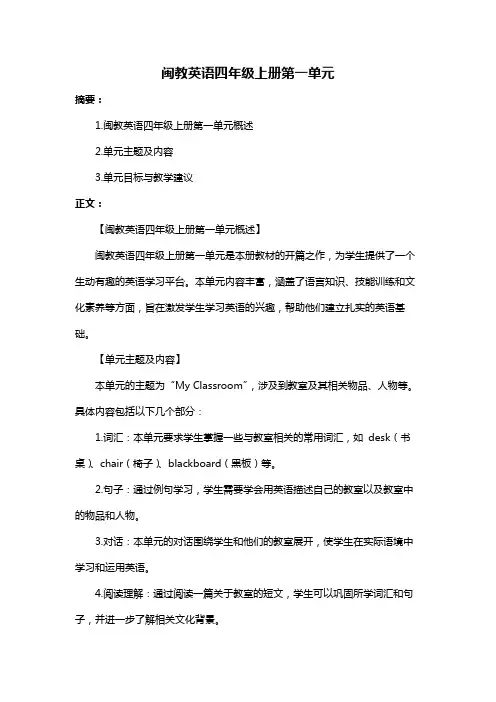
闽教英语四年级上册第一单元
摘要:
1.闽教英语四年级上册第一单元概述
2.单元主题及内容
3.单元目标与教学建议
正文:
【闽教英语四年级上册第一单元概述】
闽教英语四年级上册第一单元是本册教材的开篇之作,为学生提供了一个生动有趣的英语学习平台。
本单元内容丰富,涵盖了语言知识、技能训练和文化素养等方面,旨在激发学生学习英语的兴趣,帮助他们建立扎实的英语基础。
【单元主题及内容】
本单元的主题为“My Classroom”,涉及到教室及其相关物品、人物等。
具体内容包括以下几个部分:
1.词汇:本单元要求学生掌握一些与教室相关的常用词汇,如desk(书桌)、chair(椅子)、blackboard(黑板)等。
2.句子:通过例句学习,学生需要学会用英语描述自己的教室以及教室中的物品和人物。
3.对话:本单元的对话围绕学生和他们的教室展开,使学生在实际语境中学习和运用英语。
4.阅读理解:通过阅读一篇关于教室的短文,学生可以巩固所学词汇和句子,并进一步了解相关文化背景。
【单元目标与教学建议】
1.知识目标:学生应掌握本单元的词汇、句子和对话,能用所学语言描述教室及其相关物品和人物。
2.技能目标:学生应具备阅读理解能力,能从短文中获取信息并理解其意义。
3.教学建议:教师在教学过程中应注重培养学生的口头表达能力,鼓励他们用英语进行对话练习;同时,教师还应引导学生进行阅读训练,提高他们的阅读理解能力。
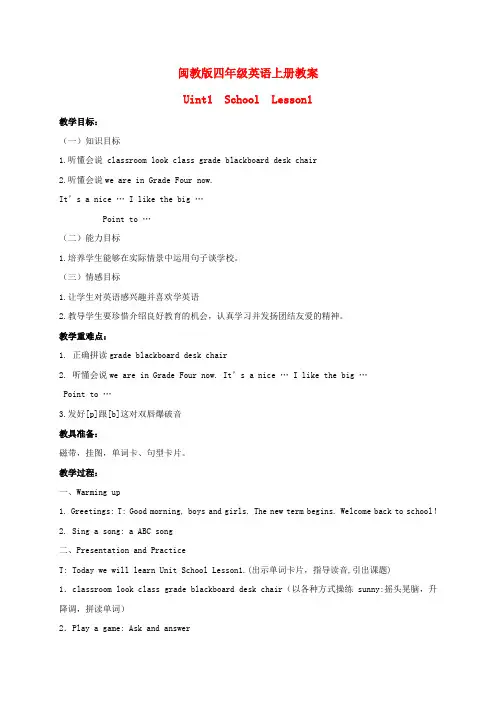
闽教版四年级英语上册教案Uint1 School Lesson1教学目标:(一)知识目标1.听懂会说 classroom look class grade blackboard desk chair2.听懂会说we are in Grade Four now.It’s a nice … I like the big …Point to …(二)能力目标1.培养学生能够在实际情景中运用句子谈学校。
(三)情感目标1.让学生对英语感兴趣并喜欢学英语2.教导学生要珍惜介绍良好教育的机会,认真学习并发扬团结友爱的精神。
教学重难点:1. 正确拼读grade blackboard desk chair2. 听懂会说we are in Grade Four now. It’s a nice … I like the big …Point to …3.发好[p]跟[b]这对双唇爆破音教具准备:磁带,挂图,单词卡、句型卡片。
教学过程:一、Warming up1. Greetings: T: Good morning, boys and girls. The new term begins. Welcome back to school!2. Sing a song: a ABC song二、Presentation and PracticeT: Today we will learn Unit School Lesson1.(出示单词卡片,指导读音,引出课题) 1.classroom look class grade blackboard desk chair(以各种方式操练sunny:摇头晃脑,升降调,拼读单词)2.Play a game: Ask and answerT: Are you in Grade Four now?S: Yes.T: Are you in Class One / Two /Three /Four?S: Yes/No.3. Listen to the tape and then reed the dialogue4. Show the teaching pictureT: help Ss to under the new text and learn the new sentencesWe are in Grade Four now.It’s a nice … ( 用单词新卡片操练句子,I like the big …并采用小组接龙的方式丰富教学方式)Point to …5.Learn the song : In the classroom四、Consolidation1. Read after the tape2. Sing the song五、Homework1.听读第1课课文三遍,然后表演给家长看(家长签字)。
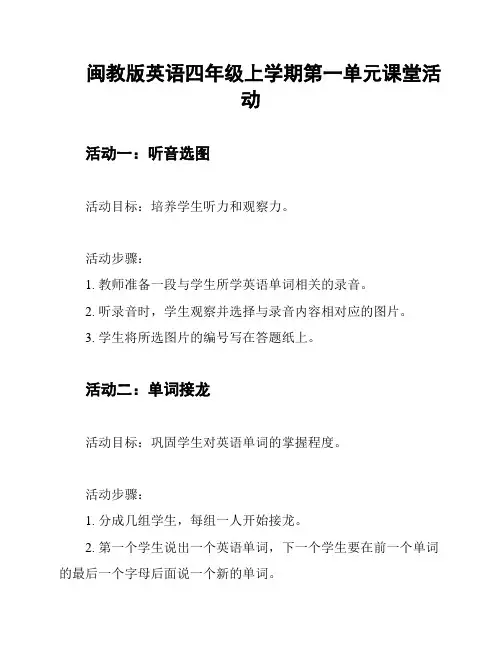
闽教版英语四年级上学期第一单元课堂活
动
活动一:听音选图
活动目标:培养学生听力和观察力。
活动步骤:
1. 教师准备一段与学生所学英语单词相关的录音。
2. 听录音时,学生观察并选择与录音内容相对应的图片。
3. 学生将所选图片的编号写在答题纸上。
活动二:单词接龙
活动目标:巩固学生对英语单词的掌握程度。
活动步骤:
1. 分成几组学生,每组一人开始接龙。
2. 第一个学生说出一个英语单词,下一个学生要在前一个单词的最后一个字母后面说一个新的单词。
3. 学生不能重复已经说过的单词,第一个不能以大写字母开头。
4. 学生如果说错单词或者迟疑超过5秒,则被淘汰。
最后留下
的学生为胜者。
活动三:角色扮演
活动目标:让学生在实践中运用所学英语表达能力。
活动步骤:
1. 教师将学生分成小组并分配每个小组的角色。
2. 每个角色都有一段对话或情景需要表演。
3. 学生们在小组内练对话,注意语音和语调的准确性。
4. 每个小组轮流表演并给予评价和鼓励。
活动四:英语歌曲欣赏
活动目标:培养学生对英语的兴趣和音乐欣赏能力。
活动步骤:
1. 教师准备一首简单的英语歌曲,如儿歌。
2. 先播放歌曲让学生熟悉曲调和歌词。
3. 学生跟着歌曲的节奏和歌词一起唱。
4. 教师和学生一起讨论歌曲内容,加深学生对歌曲的理解。
通过以上一系列的课堂活动,可以提高学生们的英语听说能力,培养他们的兴趣和自信心,让英语学习变得更加有趣和有效。
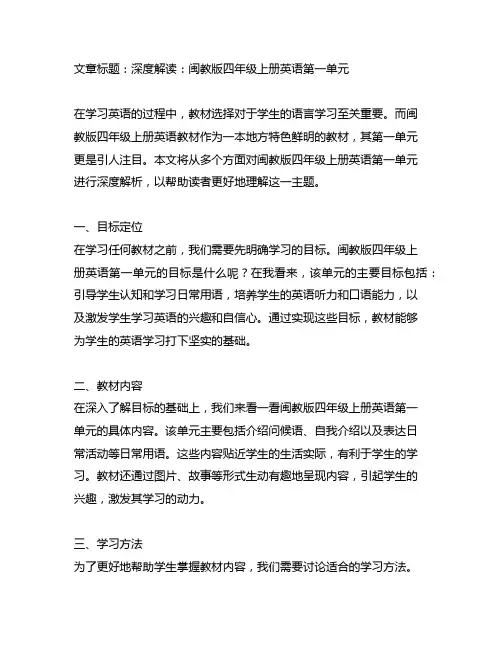
文章标题:深度解读:闽教版四年级上册英语第一单元在学习英语的过程中,教材选择对于学生的语言学习至关重要。
而闽教版四年级上册英语教材作为一本地方特色鲜明的教材,其第一单元更是引人注目。
本文将从多个方面对闽教版四年级上册英语第一单元进行深度解析,以帮助读者更好地理解这一主题。
一、目标定位在学习任何教材之前,我们需要先明确学习的目标。
闽教版四年级上册英语第一单元的目标是什么呢?在我看来,该单元的主要目标包括:引导学生认知和学习日常用语,培养学生的英语听力和口语能力,以及激发学生学习英语的兴趣和自信心。
通过实现这些目标,教材能够为学生的英语学习打下坚实的基础。
二、教材内容在深入了解目标的基础上,我们来看一看闽教版四年级上册英语第一单元的具体内容。
该单元主要包括介绍问候语、自我介绍以及表达日常活动等日常用语。
这些内容贴近学生的生活实际,有利于学生的学习。
教材还通过图片、故事等形式生动有趣地呈现内容,引起学生的兴趣,激发其学习的动力。
三、学习方法为了更好地帮助学生掌握教材内容,我们需要讨论适合的学习方法。
对于闽教版四年级上册英语第一单元,我建议采取学生为主体的、以学生为中心的学习方法。
通过和学生互动、模仿、情景模拟等方式,提高学生的学习兴趣,增强他们的学习经验。
四、反思与总结通过本文的深度评估,我们能够更全面、更深刻地理解闽教版四年级上册英语第一单元。
在学习教材的过程中,我们应该注重目标的定位,理解教材内容,灵活采用适合的学习方法,并在每个阶段进行总结和反思,以便更好地促进学习效果。
个人观点和理解在我看来,闽教版四年级上册英语第一单元的教材内容贴近学生的生活,注重学生的实际应用能力培养,是一本很好的教材。
学生在学习的过程中也需要教师的引导和家长的支持,共同为学生的英语学习助力。
闽教版四年级上册英语第一单元是一本富有地方特色的优秀教材,它为学生的英语学习提供了全面的支持和指导。
希望在未来的学习中,学生能够通过深度理解教材,更好地掌握英语,开启更加丰富多彩的语言学习之路。
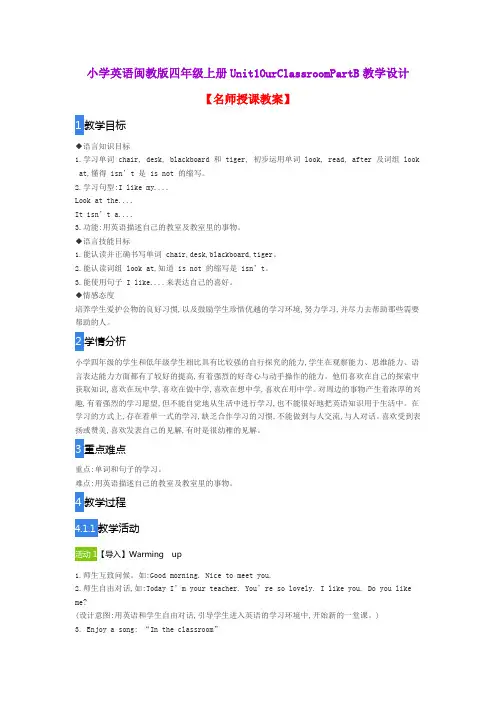
小学英语闽教版四年级上册Unit1OurClassroomPartB教学设计【名师授课教案】1教学目标◆语言知识目标1.学习单词 chair, desk, blackboard 和 tiger, 初步运用单词 look, read, after 及词组 look at,懂得 isn’t 是 is not 的缩写。
2.学习句型:I like my....Look at the....It isn’t a....3.功能:用英语描述自己的教室及教室里的事物。
◆语言技能目标1.能认读并正确书写单词 chair,desk,blackboard,tiger。
2.能认读词组 look at,知道 is not 的缩写是 isn’t。
3.能使用句子 I like....来表达自己的喜好。
◆情感态度培养学生爱护公物的良好习惯,以及鼓励学生珍惜优越的学习环境,努力学习,并尽力去帮助那些需要帮助的人。
2学情分析小学四年级的学生和低年级学生相比具有比较强的自行探究的能力,学生在观察能力、思维能力、语言表达能力方面都有了较好的提高,有着强烈的好奇心与动手操作的能力。
他们喜欢在自己的探索中获取知识,喜欢在玩中学,喜欢在做中学,喜欢在想中学,喜欢在用中学。
对周边的事物产生着浓厚的兴趣,有着强烈的学习愿望,但不能自觉地从生活中进行学习,也不能很好地把英语知识用于生活中。
在学习的方式上,存在着单一式的学习,缺乏合作学习的习惯,不能做到与人交流,与人对话。
喜欢受到表扬或赞美,喜欢发表自己的见解,有时是很幼稚的见解。
3重点难点重点:单词和句子的学习。
难点:用英语描述自己的教室及教室里的事物。
4教学过程教学活动1【导入】Warming up1.师生互致问候。
如:Good morning. Nice to meet you.2.师生自由对话,如:Today I’m your teacher. You’re so lovely. I like you. Do you like me?(设计意图:用英语和学生自由对话,引导学生进入英语的学习环境中,开始新的一堂课。
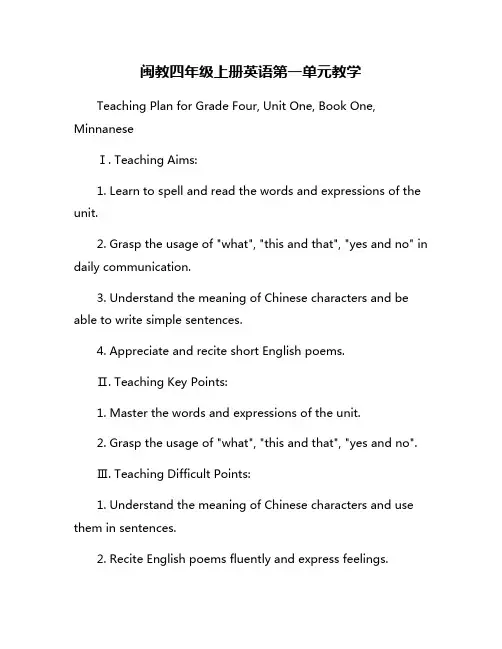
闽教四年级上册英语第一单元教学Teaching Plan for Grade Four, Unit One, Book One, MinnaneseⅠ. Teaching Aims:1. Learn to spell and read the words and expressions of the unit.2. Grasp the usage of "what", "this and that", "yes and no" in daily communication.3. Understand the meaning of Chinese characters and be able to write simple sentences.4. Appreciate and recite short English poems.Ⅱ. Teaching Key Points:1. Master the words and expressions of the unit.2. Grasp the usage of "what", "this and that", "yes and no".Ⅲ. Teaching Difficult Points:1. Understand the meaning of Chinese characters and use them in sentences.2. Recite English poems fluently and express feelings.Ⅳ. Teaching Methods:1. Task-based learning method.2. Interaction between teachers and students, as well as student collaboration.Ⅴ. Teaching Procedures:Step 1: Warm-up (5 minutes)1. Greet the students and introduce the topic of the lesson.2. Review the English words and expressions learned in the previous lesson.Step 2: Presentation (15 minutes)1. Introduce new words and expressions like "what", "this and that", "yes and no".2. Show pictures to help students understand the meanings.Step 3: Practice (20 minutes)1. Divide the students into groups and let them practice conversations using the new words.2. Create role-play scenarios for students to apply what they have learned in real-life situations.Step 4: Consolidation (15 minutes)1. Ask students to write simple sentences using the Chinese characters they have learned.2. Check the sentences and provide feedback.Step 5: Assessment (10 minutes)1. Conduct a quiz to test students' understanding of the unit.2. Review incorrect answers and explain the correct ones.Step 6: Homework (5 minutes)1. Assign students to recite the English poems learned in class.2. Ask students to practice conversations using the new words with their families.Ⅵ. Teaching Materials:1. Textbook for Grade Four, Unit One, Book One.2. Pictures and flashcards of new words and expressions.3. Whiteboard and markers.4. English poems for recitation.Ⅶ. Teaching Reflection:This teaching plan for Grade Four, Unit One, Book One, Minnanese aimed to help students master the words and expressions of the unit, grasp the usage of "what", "this and that", "yes and no", understand Chinese characters, and appreciate English poems. The teaching methods used included task-based learning, interaction between teachers and students, and student collaboration. By the end of the lesson, most students were able to use the new words and expressions in conversations and write simple sentences with Chinese characters. However, more focus could be placed on reciting English poems fluently to express feelings. Overall, the lesson was successful in achieving its teaching aims and key points.。
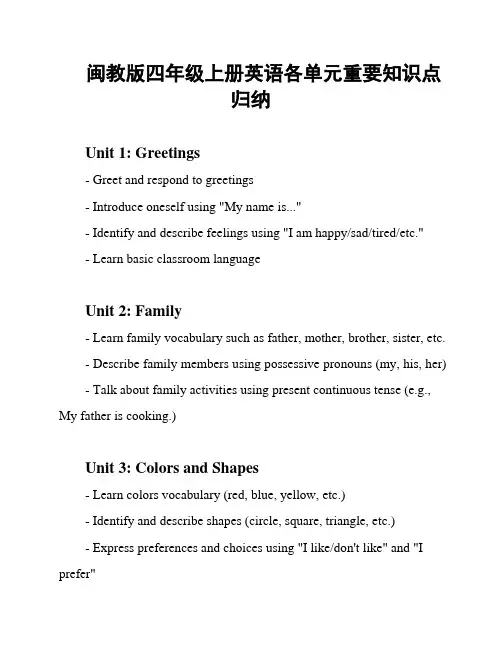
闽教版四年级上册英语各单元重要知识点归纳Unit 1: Greetings- Greet and respond to greetings- Introduce oneself using "My name is..."- Identify and describe feelings using "I am happy/sad/tired/etc."- Learn basic classroom languageUnit 2: Family- Learn family vocabulary such as father, mother, brother, sister, etc.- Describe family members using possessive pronouns (my, his, her) - Talk about family activities using present continuous tense (e.g., My father is cooking.)Unit 3: Colors and Shapes- Learn colors vocabulary (red, blue, yellow, etc.)- Identify and describe shapes (circle, square, triangle, etc.)- Express preferences and choices using "I like/don't like" and "I prefer"Unit 4: Daily Routine- Talk about daily activities using simple present tense (I get up, I brush my teeth, I go to school, etc.)- Tell the time using hours and half-hours (e.g., It's seven o'clock, It's half past two, etc.)- Discuss time-related phrases such as morning, afternoon, evening, etc.Unit 5: Food and Drinks- Learn food and drinks vocabulary- Express likes and dislikes about food using "I like/don't like" and "I love/hate"- Make requests using "Can I have...?" and "May I have...?"Unit 6: Animals- Learn animal vocabulary (dog, cat, bird, etc.)- Describe animals using adjectives (big, small, cute, etc.)- Talk about where animals live (farm, house, zoo, etc.)Unit 7: Clothes- Learn clothing vocabulary (hat, shirt, pants, etc.)- Describe clothing using colors and sizes (e.g., red hat, blue shirt, big pants, etc.)- Discuss clothing preferences and weather-related clothing choicesUnit 8: Weather- Identify and discuss different types of weather (sunny, rainy, windy, etc.)- Describe current weather using phrases like "It's sunny today" or "It's raining outside."- Talk about suitable clothing for different weather conditionsUnit 9: Feelings- Express different emotions and feelings (happy, sad, angry, etc.) - Describe situations that make one feel a certain way (e.g., I feel happy when I'm with my friends.)- Discuss appropriate responses to different feelingsUnit 10: Occupations- Learn different occupations (doctor, teacher, chef, etc.)- Describe people's occupations using "He/She is a..."- Discuss interests and aspirations related to different occupations以上是闽教版四年级上册英语各单元的重要知识点归纳,希望对你有帮助!。
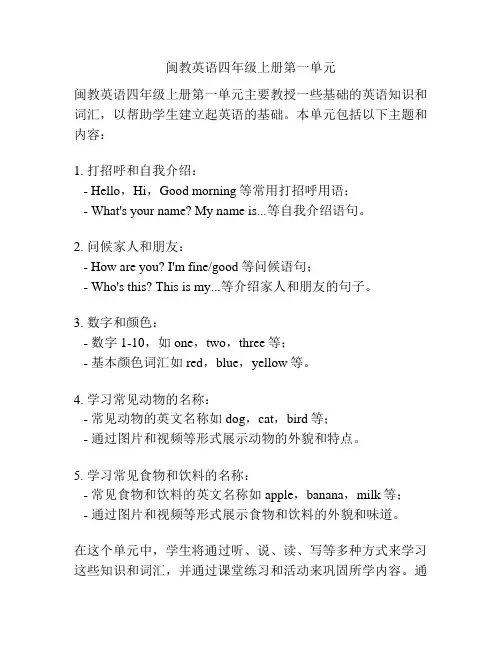
闽教英语四年级上册第一单元
闽教英语四年级上册第一单元主要教授一些基础的英语知识和词汇,以帮助学生建立起英语的基础。
本单元包括以下主题和内容:
1. 打招呼和自我介绍:
- Hello,Hi,Good morning等常用打招呼用语;
- What's your name? My name is...等自我介绍语句。
2. 问候家人和朋友:
- How are you? I'm fine/good等问候语句;
- Who's this? This is my...等介绍家人和朋友的句子。
3. 数字和颜色:
- 数字1-10,如one,two,three等;
- 基本颜色词汇如red,blue,yellow等。
4. 学习常见动物的名称:
- 常见动物的英文名称如dog,cat,bird等;
- 通过图片和视频等形式展示动物的外貌和特点。
5. 学习常见食物和饮料的名称:
- 常见食物和饮料的英文名称如apple,banana,milk等;
- 通过图片和视频等形式展示食物和饮料的外貌和味道。
在这个单元中,学生将通过听、说、读、写等多种方式来学习这些知识和词汇,并通过课堂练习和活动来巩固所学内容。
通
过这个单元的学习,学生将能够初步熟悉和运用这些基础的英语知识,为日后的英语学习打下坚实的基础。
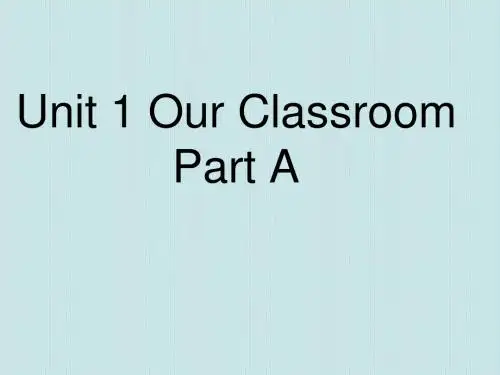
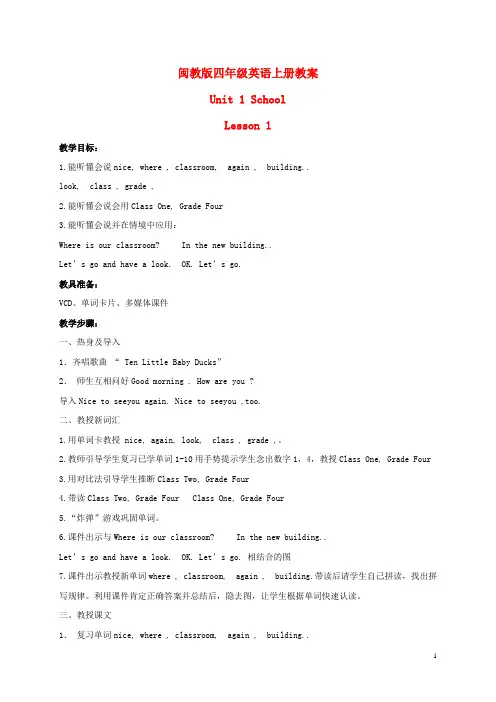
闽教版四年级英语上册教案Unit 1 SchoolLesson 1教学目标:1.能听懂会说nice, where , classroom, again , building..look, class , grade ,2.能听懂会说会用Class One, Grade Four3.能听懂会说并在情境中应用:Where is our classroom? In the new building..Let’s go and have a look. OK. Let’s go.教具准备:VCD、单词卡片、多媒体课件教学步骤:一、热身及导入1.齐唱歌曲“ Ten Little Baby Ducks”2.师生互相问好Good morning . How are you ?导入Nice to seeyou again. Nice to seeyou ,too.二、教授新词汇1.用单词卡教授 nice, again, look, class , grade ,。
2.教师引导学生复习已学单词1-10用手势提示学生念出数字1,4,教授Class One, Grade Four3.用对比法引导学生推断Class Two, Grade Four4.带读Class Two, Grade Four Class One, Grade Four5.“炸弹”游戏巩固单词。
6.课件出示与Where is our classroom? In the new building..Let’s go and have a look. OK. Let’s go. 相结合的图7.课件出示教授新单词where , classroom, again , building.带读后请学生自己拼读,找出拼写规律。
利用课件肯定正确答案并总结后,隐去图,让学生根据单词快速认读。
三、教授课文1.复习单词nice, where , classroom, again , building..look, class , grade ,教授句型 Where is our classroom? In the new building.. Let’s go and have a look. OK. Let’s go.2.“接龙”游戏练习句型。
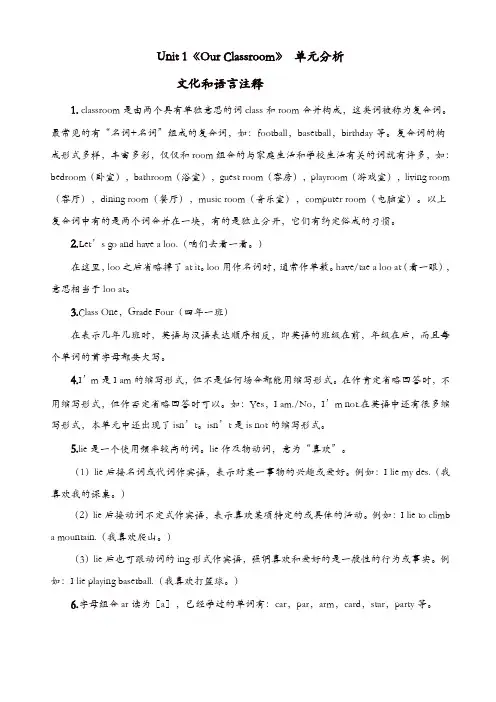
Unit 1《Our Classroom》单元分析文化和语言注释1. classroom是由两个具有单独意思的词class和room合并构成,这类词被称为复合词。
最常见的有“名词+名词”组成的复合词,如:football,basetball,birthday等。
复合词的构成形式多样,丰富多彩,仅仅和room组合的与家庭生活和学校生活有关的词就有许多,如:bedroom(卧室),bathroom(浴室),guest room(客房),playroom(游戏室),living room (客厅),dining room(餐厅),music room(音乐室),computer room(电脑室)。
以上复合词中有的是两个词合并在一块,有的是独立分开,它们有约定俗成的习惯。
2.Let’s go and have a loo.(咱们去看一看。
)在这里,loo之后省略掉了at it。
loo用作名词时,通常作单数。
have/tae a loo at(看一眼),意思相当于loo at。
3.Class One,Grade Four(四年一班)在表示几年几班时,英语与汉语表达顺序相反,即英语的班级在前,年级在后,而且每个单词的首字母都要大写。
4.I’m是I am的缩写形式,但不是任何场合都能用缩写形式。
在作肯定省略回答时,不用缩写形式,但作否定省略回答时可以。
如:Yes,I am./No,I’m not.在英语中还有很多缩写形式,本单元中还出现了isn’t。
isn’t是is not的缩写形式。
5.lie是一个使用频率较高的词。
lie作及物动词,意为“喜欢”。
(1)lie后接名词或代词作宾语,表示对某一事物的兴趣或爱好。
例如:I lie my des.(我喜欢我的课桌。
)(2)lie后接动词不定式作宾语,表示喜欢某项特定的或具体的活动。
例如:I lie to climb a mountain.(我喜欢爬山。
)(3)lie后也可跟动词的ing形式作宾语,强调喜欢和爱好的是一般性的行为或事实。
1 闽教版四年级上册英语 Unit 1 School Lesson 1 一、教学设计说明 1.基本理念 教学设计首先要关注教学的对象--学生,学生的学习准备状态或学习的起点是影响学生学习新知识最重要的因素。尊重每个学生,积极鼓励他们在学习中的尝试,保护他们的自尊心和积极性;设计要符合学生生理和心理特点,遵循语言学习的规律,力求满足不同类型和不同层次学生的需求,使每个学生的身心得到健康的发展。在教学过程中,教师应尽量使用直观教学手段,注意新旧知识的衔接,并努力做到单词教学与句型操练相组合,以利于学生发展语言技能,提高实际运用语言的能力。 2.整体设计思路 小学生的思维的基本特点是以具体形象思维逐步过渡到抽象逻辑思维为主要形式。当这种抽象逻辑思维在很大程度上,仍然是直接与感性经验相联系的仍然具有很大成分的具体形象性。可以利用现实生活与英语教学之间的共同点进行教学,以促进学生学习英语的正迁移。现代英语教学的特点就是能让学生通过各种不同的渠道和载体去接触英语,培养他们用英语获取信息和处理信息,用英语进行思维和表达的能力。 3.教学内容分析 本节课——《School Lesson 1 》,是小学四年级的Unit 1的一堂课。本节课所需课时为1课时,40分钟;本课以新的教室,新的环境为导入,开始新课的学习,这刚好符合学生的实际情况(由三年级升入四年级)。以现实生活的实际情况引导进入课程的学习。 4.教学对象分析:四年级学生通过一年的学习,已经掌握的一定的英语知识和技能,但他们仍然对英语学习具有一种直接的兴趣,在课堂上勇于发言,敢于开口,很少有羞怯感;听觉敏锐,具有较强的模范能力和机械记忆力;因此,要准确掌握学生心理,使其成为引导学生学习的有利依靠。 5.教学媒体的选择和运用:课程教学VCD、录音机、多媒体展台等。多媒体课件的采用,使知识呈现趣味、生动,贴近生活,提高学生的学习兴趣和学习效率,有助于学生思维的发展。 6.教学方法:采用全身活动法、小组合作学习法、任务驱动组织教学,歌曲、活动贯穿始终,充分调动了学生学习积极性和主动性,培养了创新思维。 二、教学内容 福建教育出版社小学英语第三册 Unit 1 School lesson1 2
(闽教版)四年级英语上册教案 unit1 lesson1教学目标能听懂、会说本课的对话并能在实际情景中应用。
学习单词和词组:building, classroom, really, again, lucky, class, grade, bright, clean, music, library, many, room, play the piano, Class One, Grade Four等。
教具准备VCD,录音带,卡片,挂图。
教学步骤和方法一热身、复习在黑板的一角写上Welcome back to our school! 创设新学期的气氛。
1.T: The new term begins. Welcome back to our school. Nice to see you again.S:Nice to see you, too.2.Sing a song: The Morning Song, 边唱边和学生握手问好。
二学说英语1.教师告诉学生王涛找不到他的新教室,建议大家发扬团结友爱的精神帮助王涛。
2.师扮演王涛提问题并请学生回答,只要能表达出基本意思就可以,而且应允许学生七嘴八舌地互相补充。
此活动可能重复做两遍。
T: Where is our classroom?S: In the new building.T: Really? Let’s go and have a look.S: All right.…3. 师边描述边出示卡片让学生认读单词和词组:先复习并背单词one, two, three, four, fiveClass One, Grade FourClassroom our classroomlibrary our librarymusic our music roompiano the new pianoplay the pianocomputer our computer room/ so many computersLook! This is our classroom. It is Class___,Grade___. The classroom is clean and bright. They are very happy. This is a music room. There is a new piano here. ___ can play the piano. This is a computer room. You can see many computers here.单词的学习要做到词不离句,要融进本课的句型里练习,让学生在本课的语境中理解、学习、运用新词汇。
闽教版四年级上册英语第一单元Unit 1: Let's PlayHello, everyone! Welcome to the first unit of Minjiang Edition Grade 4 English textbook. In this unit, we will explore the theme of "Let's Play" and learn about different sports and activities. Through interactive exercises, games, and conversations, we will enhance our English language skills. So, let's get started and have some fun!Lesson 1: Sports DayIn this lesson, we will learn about Sports Day and the different sports that children can participate in. Sports Day is an exciting event where students compete in various sports activities. It promotes teamwork, sportsmanship, and healthy competition. Some popular sports during Sports Day include running, jumping, throwing, and relay races. Students will also learn the vocabulary related to different sports in English, such as basketball, football, swimming, and cycling.Lesson 2: Let's SwimIn this lesson, we will dive into the world of swimming. Swimming is not only a fun activity but also an essential life skill that everyone should learn. We will learn the names of different swimming strokes, such as freestyle, backstroke, breaststroke, and butterfly stroke. This lesson will also focus on water safety rules and guidelines that are crucial for enjoying swimming responsibly and staying safe in the water.Lesson 3: Fun at the ParkIn this lesson, we will explore the different activities that we can do at the park. Parks are wonderful places to relax, play, and appreciate nature. We will learn new vocabulary related to park activities, such as flying kites, riding bicycles, playing on swings, and having picnics. Additionally, we will practice forming meaningful sentences using these new words and engage in conversations about our favorite park activities.Lesson 4: Let's DanceIn this lesson, we will put on our dancing shoes and learn about various dance forms. Dancing is a beautiful art form that allows us to express ourselves through movement and rhythm. We will learn the names of different dances, such as ballet, hip-hop, traditional folk dance, and ballroom dance. This lesson will also encourage us to participate in group dances, learn basic dance steps, and enjoy the joy of dancing together.Lesson 5: Musical InstrumentsIn this lesson, we will explore the world of music and different musical instruments. Music is a universal language that connects people from different cultures. We will learn about various musical instruments like the piano, guitar, violin, and drums. This lesson will focus on recognizing these instruments, understanding their unique sounds, and discussing our favorite musical pieces.Lesson 6: Let's Make CraftsIn this lesson, we will tap into our creativity and make crafts. Crafts are not only enjoyable but also a great way to enhance our fine motor skills and imagination. We will learn how to make different art and craft projects usingmaterials like paper, glue, scissors, and colors. This lesson will encourage us to follow instructions, work collaboratively, and create beautiful art pieces.ConclusionCongratulations! We have successfully completed the first unit of Minjiang Edition Grade 4 English textbook. Throughout this unit, we have learned about Sports Day, swimming, park activities, dancing, musical instruments, and making crafts. By engaging in various activities and conversations, we have improved our English language skills while having fun. Remember to practice speaking and using the new vocabulary regularly to build confidence and fluency. Good job, and let's look forward to the next unit in our English learning journey!。